Phylum Arthoropoda
Classification of Animals Non Chordates of Class 11
General Characters:
Triploblastic, bilaterally symmetrical, metamerically segmented animals.
Body covered with a thick chitinous cuticle forming an exoskeleton.
Body segments usually bear paired lateral & jointed appendages.
Body divisible into head, thorax & abdomen; head & thorax often fused to form cephalothorax.
The true coelom is reduced in adults; & is only represented by the cavities of the reproductive & excretory organs. The body cavity is a haemocoel.
Digestive system is complete; mouth parts adapted for different modes of feeding. The alimentary canal consists of stomodaeum (fore-gut), mesenteron (mid-gut) and proctodaeum (hind gut).
The respiratory organs are gills or book gills in aquatic forms and trachea or book lungs in terrestrial forms.
Circulatory system open with a dorsal heart, arteries & blood sinuses.
Excretory organs are green glands or malpighian tubules. In some forms, coxal glands are excretory organs.
Nervous system with a dorsal nerve ring & double ventral solid nerve cord.
Sensory organs comprise simple eyes, compound eyes, chemoreceptors & tactile receptors. Some forms also have statocysts.
Muscles are mostly striated.
Endocrine glands are present. Insects secrete pheromones which are used for communication between two organisms of the same species.
Sexual dimorphism is exhibited. Fertilization is internal; oviparous or ovo-viviparous; development direct or indirect. Parthenogenesis occurs in some forms.
Classification of Arthropoda
Arthropoda is a much heterogenous group including a variety of animals. Divided mainly into following sub–phyla which are further sub–divided into classes
Sub – Phylum I : Trilobitomorpha
1. Extinct
2. Fossil trilobites, mostly marine.
3. Cambrian to Permian.
e.g., Trilobites.
Sub – Phylum II : Onychophora
1. It is a small group of only 70 living species of terrestrial arthropods. Some taxonomist gave it a separate status of phylum.
2. Primitive, worm-like, unsegmented.
3. Single pair of antennae eyes and jaws.
4. Numerous stumpy, unjointed clawed legs.
5. Considered as connecting link between annelids and arthropods.
e.g. Peripatus.

Fig. Peripatus : External features in lateral view
Sub – Phylum III : Chelicerata.(chele = claw, keros = horn)
1. Body divided into an anterior cephalothorax (prosoma) and a posterior abdomen (opisthosoma)
2. One pair chelicerae, one pair pedipalp and 4 pairs of walking legs present
3. Antennae and true jaws absent.
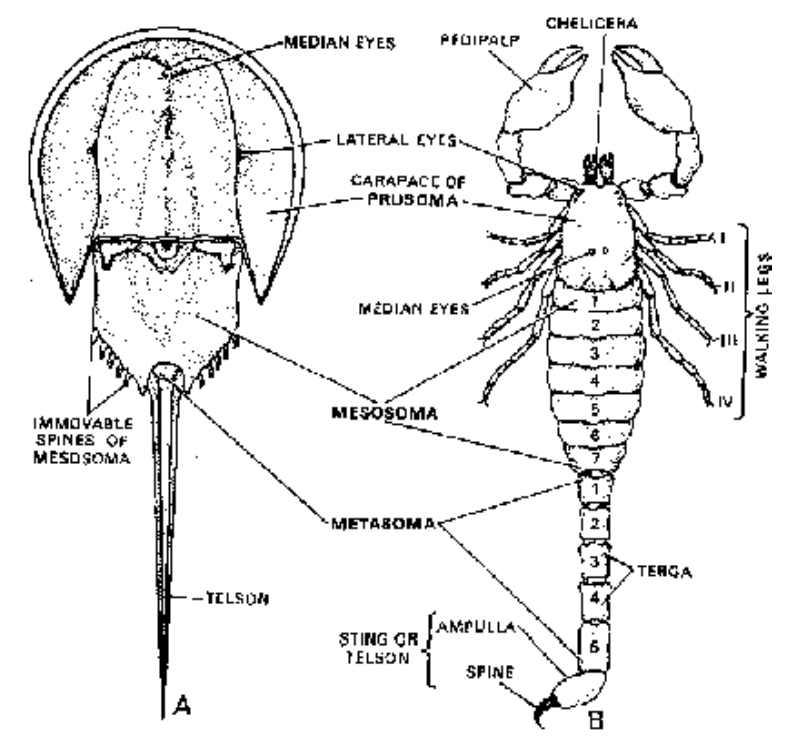
Fig. Two representative chelicerate arthropods : A. Limulus, B. Palamnaeus
It includes:
Class 1 : Merostomata
1. Marine with median simple and lateral compound eyes
2. 5 to 6 pairs of abdominal appendages with book gills.
3. Abdomen ending in a sharp telson or spine.
4. Cephalothorax in Limulus with large extended convex horse–shoe shaped carapace. e.g. Limulus (Horse shoe or King Crab).
Class 2 : Arachnida (57,000 species)
1. Terrestrial or aquatic. Eyes simple.
2. Cephalothorax with 2 chelicerae, 2 pedipalps and 4 pairs of walking legs.
3. Respiration by trachea, book lungs or both.
4. Excretion by coxal glands and malpighian tubules.
5. Dioecious, mostly oviparous.
e.g. Palamnaeus (Scorpion), Lycosa (wolf spider), Achacaranea (house spider), Dermaclntor (Dog tick).
Sub – Phylum IV : Mandibulata.
1. Body divisible into head, thorax and abdomen.
2. Head appendages are 1 or 2 pairs of antennae, 1 pair of jaws or mandibles and 1 or 2 pairs of maxillae.
3. Compound eyes common.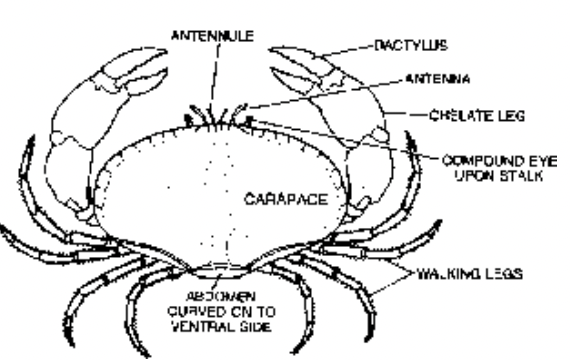
It includes :
Class 1 : Crustacea
1. Cephalothorax – formed by fusion of head and thorax.
2. Exoskeleton chitinous, hard.
3. Appendages typically biramous.
4. Respiration by gills or body surface.
5. Excretion by antennal glands.
6. Sexes usually separate. Development with
nauplius stage & other larval forms. Fig. Crab (genus cancer) — Dorsal view
e.g. Palaemon (Prawns), Leucifer (Shrimp), Cyclops, Daphnia (Water fleas), Sacculina, Palinus (true crab), Eupagarus (Hermit crab), Crayfish (Astacus).
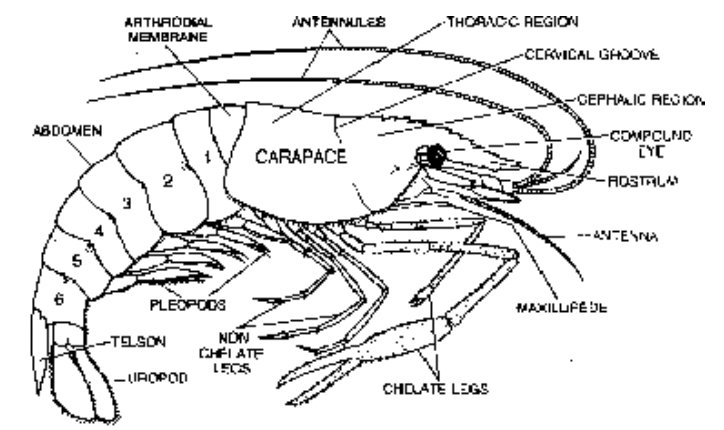
Fig. A crayfish (lateral view)
Class 2 : Insecta (Hexapoda) – 7,00,000 species
1. Body made of head thorax and abdomen
2. Head with compound eyes, antennae, mandibles and maxillae.
3. Mouth parts modified for different feeding habits.
4. Thorax with 3 pairs of jointed legs.
5. Respiration by trachea. Spiracles lateral.
6. Excretion by malpighian tubules.
7. Development usually with metamorphosis.
Sub – class 1 : Apterygota (Ametobala)
1. Primitive wingless insects.
2. Little or no metamorphosis. E.g. Lepisma (Silver fish)
Sub – class 2 Pterygota (Metabola)
1. Wings present, secondarily lost in some, metamorphosis complete or incomplete.
e.g. Poecilocercus (Grass hoppers), Schistocerca (Locust), Periplaneta (Cockroach), Mantis (Praying Mantis), Phyllium (Leaf insect), Carausius (Stick Insect), Pediculus (Human louse), Cimex (Bed bug) Apis (Honey bee) etc.
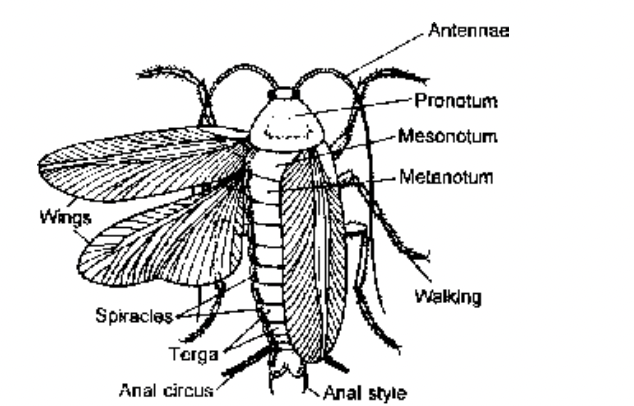
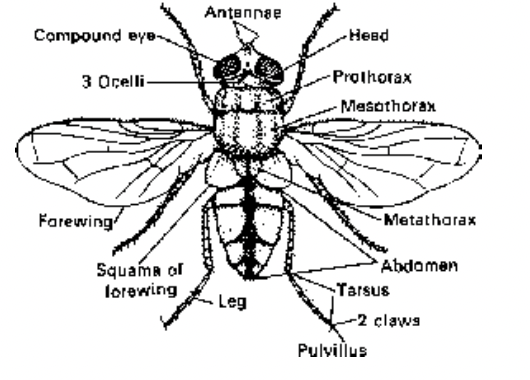
Fig. Periplaneta : External features Fig. Morphology of housefly
Class 3 : Diplopoda (Millipede)
1. Terrestrial
2. Herbivorous.
3. 70–100 pairs of legs (Two pairs of legs in each segment). e.g. Julus.
Class 4 : Chilopoda (Centipede)
1. Terrestrial.
2. Carnivorous.
3. Usually 10 – 30 pairs of legs (one pair leg in each segment).
4. Poison claws present. e.g. Scolopendra.
- Introduction
- Fundamentals of Animal Classification
- Body Plan and Symmetry
- Metamerism and Germ Layers
- Body Cavity or Coelom
- Protostomes And Deuterostomes
- Modern Classification of Animal World
- Five Kingdoms of Living World
- Kingdom Protista
- Protozoa
- Plasmodium
- Some Representatives of Phylum Protozoa
- Paramecium
- Phylum Porifera
- Canal System and Skeleton
- Some representatives of phylum - Porifera
- Cnidaria (Gr. Knide = nettle or stringing cell)
- Some representatives of phylum Coelentrata
- Phylum Platyhelminthes - The flat worms
- General Topics (Dugesia, Schistosoma, fasciola, Taneia solium)
- Important Points to Remember
- Phylum Aschelminthes
- Some representatives of Nematoda
- Phylum Annelida
- Polychaeta
- Oligochaeta
- Hirudinea
- Phylum Arthoropoda
- General Topics
- Important Points to Remember of Chelicerae
- Phylum Mollusca
- General Topics of Phylum Mollusca
- Important Points to Remember of Phylum Mollusca
- Phylum Echinodermata
- General Topics of Phylum Echinodermata
- Important Points to Remember of Phylum Echinodermata
- Exercise 1
- Exercise 2
- Exercise 3
- Exercise 4
- Exercise 5
- Exercise 6









